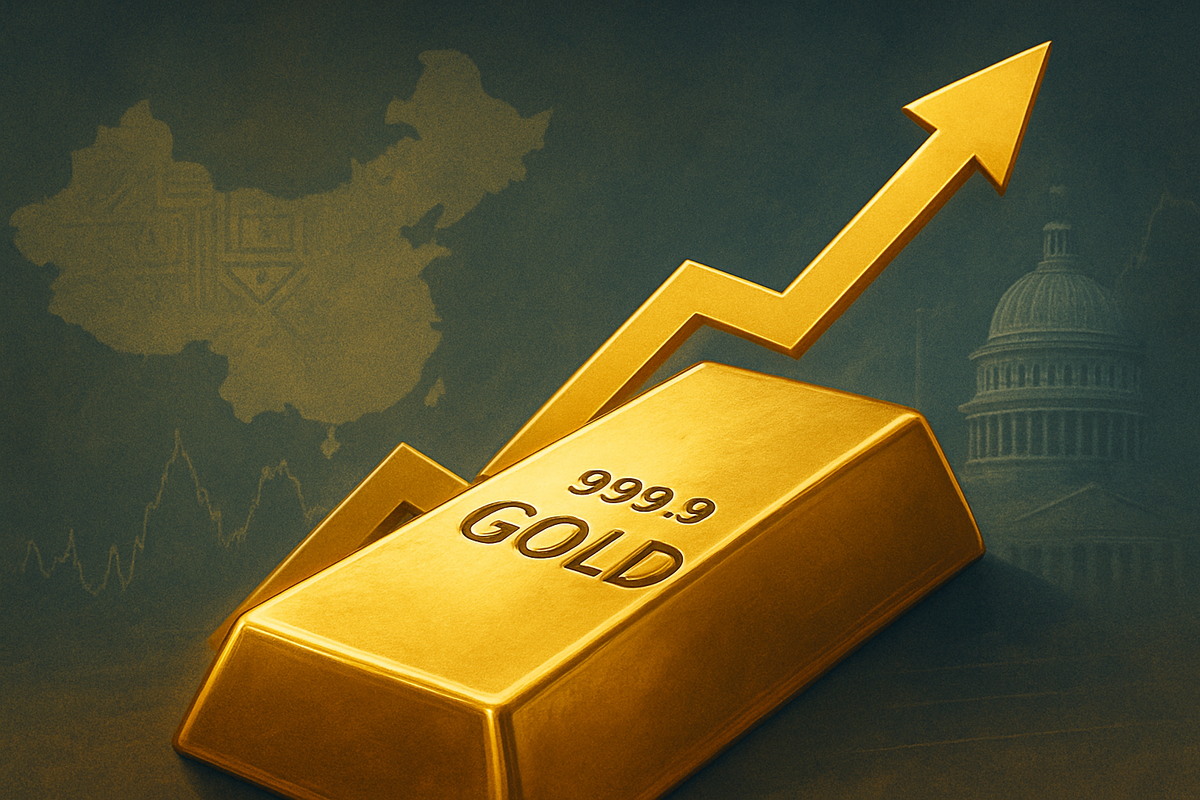
Gold prices are holding firm near an unprecedented $4,000 per ounce as of November 7, 2025, buoyed by a powerful confluence of global economic and regulatory shifts. This remarkable ascent, with spot gold trading between $3,990 and $4,012, signifies a profound recalibration in investor sentiment, positioning the yellow metal as an indispensable hedge against an increasingly uncertain financial landscape. The immediate implications point to a sustained bullish trajectory, driven by fundamental shifts in China's tax policies, ongoing U.S. silver-tariff discussions, and the pervasive "Fed risk" influencing monetary policy expectations.
This surge, which has seen gold appreciate by over 50% since the start of the year and reach an all-time high exceeding $4,380 per ounce in October 2025, reflects a growing global recognition of gold's role as a safe-haven asset. Major financial institutions, including UBS (NYSE: UBS), Morgan Stanley (NYSE: MS), Goldman Sachs (NYSE: GS), Bank of America (NYSE: BAC), and HSBC (NYSE: HSBC), have revised their price targets upwards, with some analysts forecasting gold to potentially reach $5,000-$5,600 by 2026. This re-evaluation underscores a significant departure from traditional portfolio strategies, as investors seek refuge from economic volatility and a weakening U.S. dollar.
The Golden Surge: Decoding the Drivers Behind Gold's Ascent Towards $4000
The current bullish momentum in the gold market is underpinned by three critical pillars: a transformative tax shift in China, contentious silver-tariff discussions in the United States, and the looming uncertainty surrounding Federal Reserve policy. Each factor, while distinct, contributes to an environment ripe for gold's appreciation.
Effective November 1, 2025, China, the world's largest gold consumer, implemented a significant reform in its gold trading tax system. The long-standing value-added tax (VAT) exemption on gold sales has been abolished, aiming to enhance market oversight, curb speculative demand, and close tax loopholes. Under the revised regulations, investment-grade gold traded on exchanges remains VAT-exempt unless physically withdrawn. However, gold categorized as consumption, such as jewelry or industrial-use gold, is now subject to a 6% deductible VAT rate, a reduction from the previous 13%. While designed to streamline the market and boost government revenue, this policy is anticipated to elevate gold prices within China and potentially temper domestic consumer demand, particularly for luxury gold items. The ripple effect of any slowdown in Chinese demand on global market dynamics remains a key consideration for analysts.
Concurrently, discussions surrounding U.S. silver tariffs are adding another layer of uncertainty to the precious metals market. On November 6, 2025, the U.S. Department of the Interior officially added silver to its list of "critical minerals." This designation significantly increases the probability of silver being included in future tariff policies, drawing parallels to broader U.S. trade protectionism. Although not directly impacting gold, the broader context of U.S. tariff measures, coupled with an ongoing U.S. government shutdown and a Supreme Court review of tariff legality, fuels economic uncertainty. This environment typically bolsters demand for safe-haven assets like gold, as investors seek stability amidst trade tensions and political gridlock. The parallel strong performance of silver, which has also seen substantial gains, highlights a broader rally across precious metals driven by systemic economic concerns.
Finally, the pervasive "Fed risk" is a dominant factor in gold's current trajectory. Market expectations are heavily skewed towards a near-term Federal Reserve rate cut, with over a 70% probability priced in for a December reduction. This sentiment is largely driven by recent soft labor data, including a significant increase in job cuts in October and a sharp decline in consumer confidence. Lower interest rates reduce the opportunity cost of holding non-yielding assets such as gold, making them more attractive to investors. However, this expectation has been somewhat tempered by recent hawkish comments from some Fed officials and stronger-than-expected private sector employment and ISM services data. The prolonged U.S. government shutdown further exacerbates economic uncertainty by creating an information vacuum, which historically strengthens gold's appeal. The "Fed risk" encapsulates the unpredictability of future Federal Reserve policy and its potential impact on inflation and the U.S. dollar—both critical drivers for gold's upward momentum.
Market Movers: Who Wins and Who Loses as Gold Shines
The surge in gold prices towards the $4,000 mark creates a distinct bifurcation in the market, carving out clear winners and potential losers across the precious metals ecosystem. This dynamic is profoundly shaped by the interplay of China's tax reforms, potential U.S. silver tariffs, and the Federal Reserve's monetary policy trajectory.
Gold mining companies stand as the primary beneficiaries of this unprecedented rally. With gold prices consistently trading near or above $4,000 per ounce, their revenue streams are significantly bolstered, and profit margins expand dramatically. For major producers, whose all-in sustaining costs (AISC) often hover around $1,400 per ounce, the current price environment translates into extraordinary free cash flow. This financial windfall empowers them to invest more heavily in exploration, expand existing operations, and pursue strategic acquisitions. Companies like Agnico Eagle Mines (NYSE: AEM / TSX: AEM), which reported robust revenues and substantial free cash flow in Q3 2025, are direct beneficiaries. Similarly, Newmont (NYSE: NEM) and Barrick Gold (NYSE: GOLD / TSX: ABX) are poised to capitalize on these elevated prices. Junior gold miners, such as Formation Metals (CSE: FOMO / OTCQB: FOMTF), often exhibit even greater leverage to gold price movements, with their earlier-stage projects becoming more attractive to major producers seeking to expand reserves. The VanEck Junior Gold Miners ETF (NYSEARCA: GDXJ) has already seen a significant year-to-date gain, reflecting this amplified positive sentiment.
Precious metals refiners and dealers also stand to gain from increased market activity. Higher investor interest and trading volumes in gold translate directly into greater demand for their refining and dealing services. Companies like Umicore SA (EBR: UMI) and Glencore International AG (LSE: GLEN), involved in the refining and trading of precious metals, would experience heightened operational volumes and potentially increased transaction fees. Financial institutions with significant gold exposure, including those offering gold-backed products or managing gold investments, are likewise positioned favorably. Major banks and asset managers such as UBS (NYSE: UBS), Morgan Stanley (NYSE: MS), Goldman Sachs (NYSE: GS), Bank of America (NYSE: BAC), and HSBC (NYSE: HSBC), who have issued bullish forecasts for gold, benefit from increased client interest and inflows into gold-related assets and ETFs.
Conversely, China's new tax oversight presents a challenge for domestic gold retailers and processors. The abolition of the full VAT exemption on gold sales, particularly for physical gold categorized as consumption (like jewelry), means higher operational costs. Retailers like Laopu Gold (SHA: 603038) and Chow Tai Fook Jewellery Group (HKG: 1929) have already seen their shares drop following the announcement, as they face the difficult choice of absorbing increased costs or passing them on to consumers, potentially dampening demand in the world's largest consumer market. While investment-grade gold on exchanges remains VAT-exempt, the broader physical gold market for consumption will feel the pinch.
The discussions around U.S. silver tariffs also introduce a complex dynamic. While potentially benefiting U.S. domestic precious metals miners and refiners by making imported metals more expensive and increasing demand for locally sourced products, these tariffs could penalize importers of precious metals and industries heavily reliant on imported silver. Manufacturers in sectors like solar panels, electric vehicles, and electronics, which use silver as a critical input, could face escalating material costs, supply chain disruptions, and reduced competitiveness if these tariffs are implemented. The overarching "Fed risk" also carries a nuanced threat; while current expectations favor rate cuts, an unexpected hawkish pivot by the Federal Reserve could reduce gold's appeal, negatively impacting all gold-exposed companies by dampening prices.
Beyond the Brink: The Broader Implications of Gold's Rally
The sustained rally of gold towards the $4,000 per ounce threshold transcends mere price movements, signaling profound shifts in global economic paradigms and investor psychology. This valuation reflects a complex interplay of broader industry trends, impacts on competing assets, and significant regulatory and geopolitical implications, echoing historical periods of economic uncertainty.
A pivotal broader trend driving gold's ascent is the unprecedented demand from central banks globally. For 16 consecutive years, central banks have been net buyers of gold, accumulating record amounts to diversify their reserves away from the U.S. dollar and fortify against geopolitical risks. This strategic pivot underscores a growing distrust in fiat currencies and a desire for tangible assets amidst increasing global instability, including ongoing conflicts, rising protectionism, and trade tensions. Furthermore, persistent inflation concerns in major economies, coupled with a weakening U.S. dollar and expectations of lower real interest rates from central banks like the Federal Reserve, enhance gold's appeal as a robust hedge against currency debasement and eroding purchasing power. The increasing institutional and ETF inflows into gold further solidify its position as a preferred safe haven, especially amid concerns of potential "bubbles" in the technology sector and mounting government debt globally.
The ripple effects of gold's strong performance extend across the entire spectrum of investments. Other precious metals have benefited significantly from this "debasement trade" into hard assets. Silver, for instance, has experienced substantial gains and indications of structural tightness in physical supply, while platinum and palladium have also seen considerable year-to-date increases. In the realm of alternative investments, gold is increasingly valued for its low correlation to traditional stock and bond markets, serving as a crucial diversifier during periods of financial stress. While real estate and other commodities offer inflation hedging, gold's demand drivers are distinct, primarily driven by its safe-haven status rather than cyclical industrial demand. Even cryptocurrencies, often touted as digital gold, face a contrast with gold's millennia-long history as a store of value, highlighting differing risk profiles and investor motivations. Industries reliant on gold, such as electronics, nanotechnology, and jewelry, are confronting increased production costs, prompting innovation in material usage and a potential shift towards more cost-efficient designs or alternative materials.
Beyond the specific tax and tariff discussions, the sustained high gold prices carry significant broader regulatory and policy implications. Central banks are closely monitoring these movements, as excessive gold appreciation can signal market expectations of future inflation or financial instability, potentially influencing monetary policy decisions on interest rates and money supply. A consistently strong gold price, particularly when driven by a weakening U.S. dollar, also pressures currency stability and exchange rates, reflecting a broader erosion of confidence in fiat currencies. The strategic accumulation of gold by central banks is a geopolitical maneuver, aimed at reducing reliance on any single reserve currency and mitigating risks from potential sanctions or asset freezes, thereby reflecting shifting global economic power dynamics. Furthermore, domestic events like the recent U.S. government shutdown, by amplifying economic uncertainty, directly contribute to safe-haven demand for gold and can influence Federal Reserve decisions.
Historically, gold has consistently proven its mettle during times of crisis. Its surges during the post-Nixon shock of the 1970s (when it soared over 400%), the 2008 Global Financial Crisis (surging 78% within two years), and the COVID-19 pandemic (rising 32% in eight months) underscore its enduring role as a reliable store of value. The current environment, characterized by record central bank buying, persistent fiscal deficits, geopolitical competition, and concerns about financial stability, strongly echoes these historical precedents. While short-term volatility is always a possibility, the structural bull case for gold appears robust, suggesting its critical role in diversified portfolios will only grow.
The Road Ahead: Navigating Gold's Future Landscape
As gold firmly establishes its position near $4,000 per ounce, the path forward for the yellow metal is characterized by both near-term volatility and a robust long-term bullish outlook. Market participants must strategically adapt to this new environment, where economic uncertainty, geopolitical shifts, and central bank actions will continue to dictate gold's trajectory.
In the short term, following November 7, 2025, gold prices are expected to exhibit continued volatility but remain generally well-supported around the $4,000 level, potentially consolidating within a range of $3,800 to $4,050 per ounce. Key immediate drivers will include fluctuations in the U.S. dollar, which tends to move inversely to gold, and ongoing speculation regarding the Federal Reserve's monetary policy. While market sentiment strongly anticipates further interest rate cuts, the timing and magnitude remain subjects of intense scrutiny. Persistent geopolitical tensions and the unwavering demand from global central banks, who continue to diversify their reserves, will provide a structural floor for prices. Analysts suggest gold could touch $4,200 per ounce in the coming months if these supportive conditions persist, though a sustained strong dollar or a period of unexpected market calm could introduce downward pressure.
Looking further ahead, the long-term outlook for gold beyond 2025 remains overwhelmingly bullish. Major financial institutions forecast gold prices to average well above $4,000 per ounce, with some projections reaching $5,000-$5,600 by 2026. More ambitious long-term scenarios envision gold soaring to $7,000-$7,400 per ounce by late 2027 or early 2028, and even potentially $10,000 by 2030 under extreme inflation or de-dollarization scenarios. These long-term projections are underpinned by persistent inflation risks, continued heavy gold buying by central banks, enduring economic uncertainty, a weakening U.S. dollar, and the structural trend of de-dollarization. Potential structural supply deficits in precious metals further reinforce this bullish perspective.
Strategic pivots will be essential for various market participants. Investors are increasingly viewing gold as a core portfolio asset and a critical diversifier, with some financial advisors recommending allocations of up to 15%. Strategies such as dollar-cost averaging into gold investments, exploring fractional gold options, and gaining exposure through gold mining stocks or precious metals streaming/royalty businesses (e.g., via ETFs like the VanEck Gold Miners ETF (NYSEARCA: GDX)) are becoming more prevalent. A long-term mindset, viewing gold as insurance against financial instability rather than a short-term trade, is paramount. For the gold mining industry, sustained high prices translate into increased revenues and profitability, fostering expansion and the development of new reserves, though diligent operational cost management remains crucial amidst inflationary pressures. Central banks are expected to maintain their strategic gold purchases, acting as a consistent demand factor regardless of short-term market fluctuations.
Emerging markets face both significant opportunities and challenges. Gold-producing nations like Uzbekistan, Kazakhstan, South Africa, and Ghana stand to gain from improved terms of trade, export growth, and increased fiscal revenues, enhancing their external buffers. These markets are also becoming major buyers of gold, actively diversifying away from the U.S. dollar. However, countries with a high proportion of gold in their reserves, such as Uzbekistan, face diversification risks if prices unexpectedly reverse. Regulatory hurdles for new mining projects and the inherent volatility of commodity markets remain challenges. Moreover, rising gold prices could dampen jewelry demand in major consuming emerging markets like India and China, although seasonal demand often provides some resilience.
Several potential scenarios could unfold. A highly bullish scenario could see gold surge to $4,500-$7,000+ if persistent high inflation, aggressive Federal Reserve rate cuts, escalating geopolitical tensions, a deep economic slowdown, or accelerated de-dollarization take hold. A more moderate scenario might see gold consolidate between $3,500 and $4,500 if global growth stabilizes, rate cuts slow, geopolitical tensions ease, or the U.S. dollar strengthens. A less likely, but possible, bearish scenario involving a correction below $3,800 could occur if central bank demand unexpectedly decreases, the U.S. economy shows unusual resilience, or an unforeseen cycle of aggressive rate hikes emerges.
Final Verdict: A New Era for the Yellow Metal
The current positioning of gold near the $4,000 per ounce mark, as of November 7, 2025, is more than just a fleeting market peak; it signifies a profound and potentially lasting transformation in the global financial landscape. This remarkable rally, fueled by a potent mix of geopolitical instability, anticipated Federal Reserve rate cuts, unprecedented central bank demand, and persistent inflation concerns, underscores gold's re-emerged role as a critical safe-haven asset and a vital component of diversified portfolios.
The key takeaways from this golden surge are clear: gold's traditional function as a refuge during times of uncertainty has been profoundly reasserted. The strategic accumulation by central banks globally reflects a deep-seated distrust in fiat currencies and a deliberate move away from an over-reliance on the U.S. dollar for reserve diversification. Furthermore, the ongoing "Fed risk" and the broader economic uncertainties, exacerbated by events like the U.S. government shutdown, highlight a pervasive need for tangible assets that offer stability amidst financial volatility. China's tax reforms, while tempering domestic consumption, are also pushing investors towards more accessible gold investment vehicles, further integrating gold into modern financial strategies.
Assessing the market moving forward, the consensus among major financial institutions remains largely bullish for gold through the remainder of 2025 and into 2026, with price targets often extending well above $4,000 and even $5,000 per ounce. While short-term corrections due to profit-taking or temporary shifts in the U.S. dollar are possible, the structural drivers for gold's appreciation appear robust. The gold mining sector, in particular, is experiencing unprecedented profitability, leading to increased investment in exploration and strategic acquisitions, which could reshape the industry landscape.
The lasting significance of gold's sustained rally lies in its role as a critical barometer of global caution. It reflects not only deep concerns about economic stability and currency reliability but also a structural transformation in investor and central bank behavior. Gold's prominence has expanded to embody not just an economic hedge, but also a strategic tool for national sovereignty protection in an increasingly fragmented geopolitical environment. This era heralds a fundamental re-evaluation of how gold is perceived and integrated into both national and individual wealth preservation strategies.
For investors in the coming months, vigilance is key. Closely monitor Federal Reserve monetary policy statements and economic data, particularly regarding inflation and employment, as these will directly influence interest rate expectations. Keep a keen eye on the U.S. Dollar Index (DXY). A weakening dollar typically correlates with rising gold prices, making gold more affordable for non-US investors. Geopolitical developments, central bank gold activity, and shifts in broader market sentiment and risk appetite will also be crucial indicators. Investors are advised to approach gold with a long-term perspective, recognizing its role in wealth preservation and portfolio diversification rather than seeking short-term speculative gains. Considering physical gold, well-known bullion, or reputable gold-backed ETFs can be prudent strategies. The current market environment suggests that gold's prominence as a strategic asset is not merely a transient phenomenon but a reflection of an evolving global economic and geopolitical order that is likely to endure.
This content is intended for informational purposes only and is not financial advice






